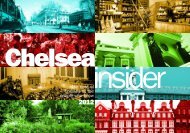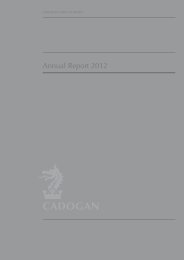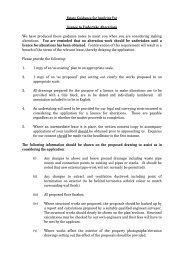Chelsea Insider Low - Cadogan
Chelsea Insider Low - Cadogan
Chelsea Insider Low - Cadogan
- No tags were found...
You also want an ePaper? Increase the reach of your titles
YUMPU automatically turns print PDFs into web optimized ePapers that Google loves.
36 | THINGS TO DO | Film and theatrecamera in 1839, and experimented withcolour and motion pictures. By 1934, ahuge cinema – the Gaumont Palace –had replaced his studio. A bas relief ofhis image can still be seen on the façadeof the building.Designed by William E Trent andErnest F Tully, it had seating for 2,502and included a fully-equipped stage, arehearsal room, dressing rooms and aCompton theatre organ. It became theGaumont Theatre from 1937 and wasmodernised in 1960. It was renamed theOdeon in 1963 but closed its doors in1972. The foyer and stalls becameHabitat, while the stage became flatsand offices.A new Odeon cinema opened inSeptember 1973, seating 739, occupyingthe former balcony area, but it closedin 1981. After the cinema had been darkfor two years, distributor Artificial Eyetook it over and renamed it the <strong>Chelsea</strong>Cinema. It joined Curzon Cinemas in2006, and became the Curzon <strong>Chelsea</strong>after extensive refurbishment in 2010mboasting the biggest screen outside theWest End. The auditorium has 713 seats,some of which are luxury ‘Pullman’seats, and the cinema also has a bar.Ticket prices: Adults £10.50, Cineaste(Curzon members) £8.50, Pullman seats£15/£13 Cineastes (Monday-Friday after5pm, Saturday and Sunday after 2pm).Cinesaver (Monday-Friday 2pm-5pm)£7.50 adults, £6.50 Cineaste, £11/£9Pullman seats. Early bird (open to 2pm)£7.50 adults, £6 Cineaste £5, £9/£8Pullman seats. Children (under 15) £6 atall times. There is a surcharge of £2 onall tickets for 3D films. The cinema is currentlyinaccessible to wheelchair users,but staff can offer assistance with stairs ifyou phone in advance to discuss yourneeds.206 King’s Road, SW3 5XPT: 0330 500 1331www.curzoncinemas.com/cinemas/chelsea/Film locationsWith its diverse architecture and rich history,<strong>Chelsea</strong> has always been in demand as alocation for films. Here are just a few of themovies that have scenes shot in the areaBlow-Up (1966)Michelangelo Antonioni’s thriller sees glamorousfashion photographer Thomas (DavidHemmings) showing his portfolio to hisagent, Ron (Peter Bowles), in El Blason,8-9 Blacklands Terrace, and attending aparty on Cheyne Walk.A Clockwork Orange (1971)The McDonalds on the King’s Road used tobe the <strong>Chelsea</strong> Drugstore, which doubledas a record store visited by Alex (MalcolmMcDowell) in Stanley Kubrick’s iconic film.Withnail and I (1986)Monty, played by Richard Griffiths, lives at35 Glebe Place and is visited by hisnephew Withnail (Richard E Grant) and hisfriend, played by Paul McGann and namedonly as ‘…& I’ in the end credits. BruceRobinson’s black comedy is a cult favouriteand counts Beatle George Harrison as oneof its executive producers.Match Point (2005)Scarlett Johansson’s American actresscharacter Nola auditions for a role at theRoyal Court Theatre in Woody Allen’s thriller.A Good Year (2006)The iconic Bluebird Café on the King’sRoad features in Ridley Scott’s romanticcomedy.Alex Rider: Stormbreaker (2006)Adapted from Anthony Horowitz’s novel,this film stars Alex Pettyfer as teenage spyAlex Rider, who lives in St Leonard’sTerrace.Royal Court TheatreThe Royal Court is a non-commercialtheatre renowned for its work championingnew writing and staging landmarkplays, such as John Osborne’s LookBack in Anger and Edward Bond’sSaved. Its ongoing writers programmesand festivals, including Rough Cuts andthe Young Writers Programme, havehelped to launch the careers of newvoices such as Mike Bartlett, LucyPrebble, Polly Stenham, Laura Wade andBola Agbaje.The Royal Court – originally called theCourt Theatre – was built by WalterEmden and opened in 1888. It becamefamous for its George Bernard Shawseasons. It was used as a cinema from1932-1935, after which it closed for awhile, and was damaged in the SecondWorld War. After the war, it presentedlight musical reviews.In 1952, former music hall performerAlfred Esdaile acquired the lease of thetheatre and the land next to SloaneSquare underground station from the<strong>Cadogan</strong> Estate, and reopened thebuilding as a theatre club. The EnglishStage Company, led by artistic directorGeorge Levine, made the Court its homein 1955. Look Back in Anger opened atthe theatre in 1956 – the start of a newera of modern British drama.The Royal Court has also been instrumentalin the abolition of censorshipon the London stage, with Osborne’sA Patriot For Me and Bond’s Saved andEarly Morning being refused a licenceto be performed in public by the LordChamberlain’s Office in the 1960s. Therole of official censor was abolished in1968.In 1966, the Young People’s Theatrewas set up to develop and produce newwriting by writers under 25 years old,and the Young Writers Festival, now aregular event, was launched in 1973.The Theatre Upstairs, one of the firstArtisticdirectors at theRoyal CourtTheatre2007 – 2013: Dominic Cooke1998 – 2006: Ian Rickson1992 – 1998: Stephen Daldry1979 – 1992: Max Stafford-Clark1977 – 1979: Stuart Burge1975 – 1977: Robert Kidd andNicholas Wright1972 – 1975: Oscar Lewenstein1969 – 1972: William Gaskill,Lindsay Andersonand Anthony Page1965 – 1969: William Gaskill1956 – 1965: George Devine







